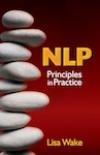Paul Turner has reviewed a new book about the practical uses of the controversial technique of NLP. Would this book be useful to you?

Book: NLP: Principles in Practice
Author: Lisa Wake
Publisher: Ecademy Press, 2010
For those curious to discover what NLP really encompasses, for those who want to extend their knowledge of NLP beyond the few concepts they currently understand, or for those sceptical that any practical benefit can be offered by such an esoterically titled subject, then Lisa Wake's very thoughtfully designed book will certainly be of value to you all.
This excellent addition to the introductory category of NLP literature also has the advantage of providing a readily accessible resource for those of us who want to quickly refresh our memory of particular aspects of the extensive landscape of the main NLP techniques, tools and methodologies. This is definitely a book to keep close at hand when both planned and opportunistic possibilities to use NLP arise.
A significant feature that weaves its way through the book is the author's drive for providing an evidence-based approach where possible. This aids both understanding of the concepts and clearly indicates the contexts in which NLP can usefully be applied.
The first chapter provides a very brief summary background to the subject and the key contributions of three therapists, Virginia Satir, Fritz Perls and Milton Erickson who were modelled by Grindler and Bandler.
Chapter two lays out important foundational concepts and is consequently one which is useful to occasionally pause and return to when reading the remaining chapters. It provides a summary of the historical development of NLP to the present time from two perspectives. An amended and updated standard map of NLP is the first. The second perspective illustrates the influences on the NLP map of the contributions of Satir, Perls, Erickson and Bateson. A number of definitions of NLP are provided, including those from contexts in which NLP is applied e.g. sport, management, education and therapy. Also and importantly, Lisa has included a summary of the presuppositions of NLP, in this case, the 15 detailed by Robert Dilts.
Chapter two is also the first in the book which is structured in the same way as the following ten – I found this a very useful feature. Each chapter covers groups of tools and techniques and collected under chapter titles which include 'goal setting and outcomes', 'understanding other people', 'viewing things from alternative perspectives', 'change management', 'the language of NLP' and 'performance excellence'. For example, the chapter on 'changing the pictures, sounds and feelings of how we think' contains the subjects of submodalities, mapping across, strategies and anchoring. Swift use of Amazon's 'Look Inside' tool on its book website illustrates the wide range of topics she has covered.
"This is definitely a book to keep close at hand when both planned and opportunistic possibilities to use NLP arise."
The common chapter framework provides an overview and rationale for each component tool/technique or philosophy. Any relevant literature drawn from reviews conducted by Lisa that either support or challenge the model is included. Any concepts directly related to the subject matter are summarised, as are the principles of why a particular technique works and how it links back to the overarching theory and principles of NLP. How the technique works is then described followed by the key steps involved in applying the technique. Each section then concludes with a recommended exercise to follow and examples of how the technique can be applied across a number of different concepts. The exercises Lisa has chosen certainly stimulate thinking and learning and are a valuable feature of this book.
The concluding twelfth chapter briefly reviews NLP as it has developed in a number of contexts, some sources of further learning and a list of reference sources to expand and deepen readers' exploration of the topic. While there are considerable benefits of Lisa's skilfully succinct style, I wish she would have expanded some of the content here, particularly in the practical usage of NLP in specific contexts, such as in business. It would have been an opportunity to share, in a summarising way, the evidence base she already identified in previous chapters with the perspectives drawn from her own experience over a number of years of applying some of the techniques in various business contexts.
She then poses the 'where to next?' question and summarises three potential scenarios for NLP generated by Tosey and Mathison (2009). Entropy – where the previous levels of development energy for NLP decline, resulting in growing dispersion and disorder. Sowing seeds of its own destruction – a possible outcome of the growing diversity of opinion of how to train and regulate core standards for NLP practitioners. Finally, a more positive trend, Renaissance – in which NLP embraces new and emerging theories eg. neuroscience and acts as a complementary toolkit and knowledge base for other practices.
Taking up the renaissance theme, Lisa argues that NLP practice needs to apply itself to the principle of modelling excellence and follow a path of developing to meet the systemic and societal needs and expectations of the 21st century. She suggests some ways that NLP may initially approach this are by conducting empirical research studies to demonstrate effectiveness using qualitative, quantitative and practice based evidence; agreeing standards for training; a requirement for continuing professional development and the establishment of a compulsory code of ethics and conduct for NLP practitioners. No controversy here then!
Lisa has packed a great deal of useful, clear information about NLP into these 218 pages. I readily recommend you delve into them.










